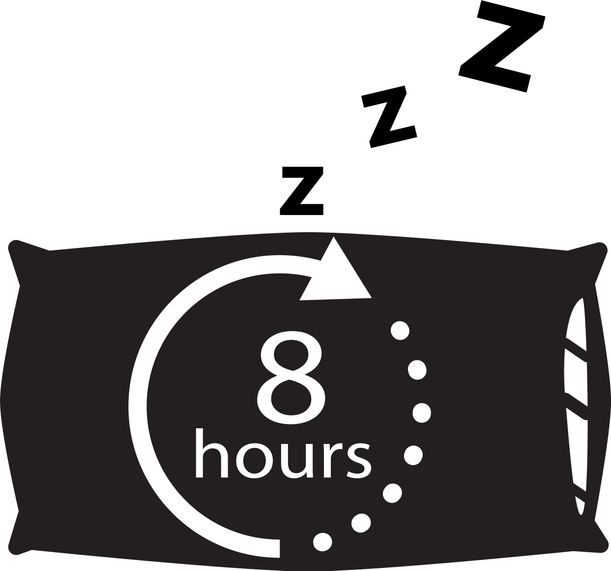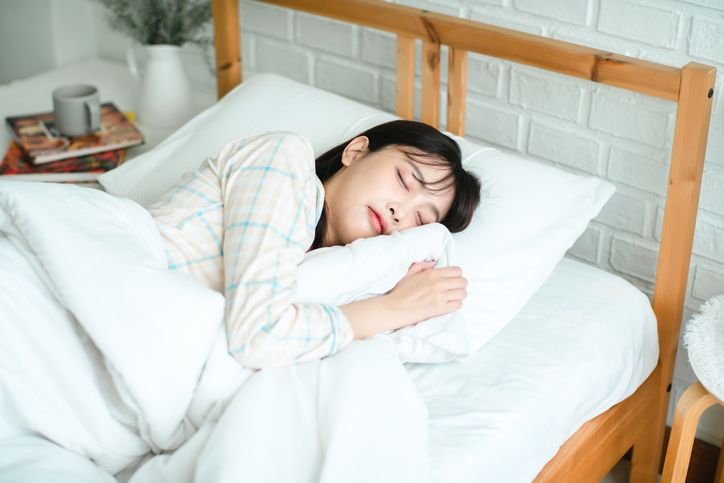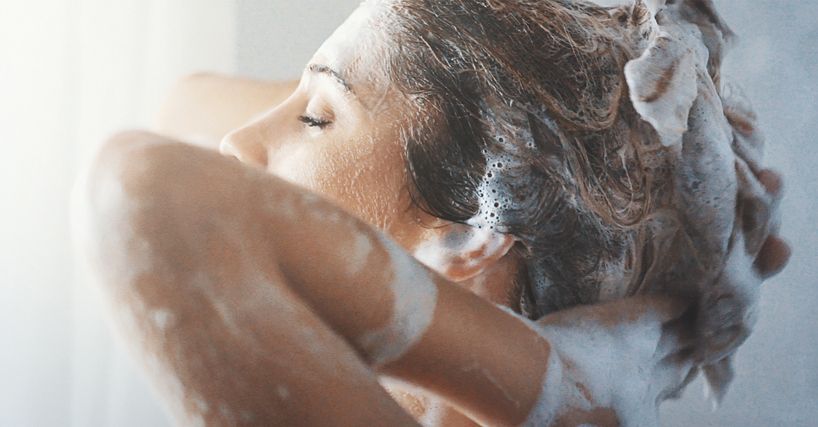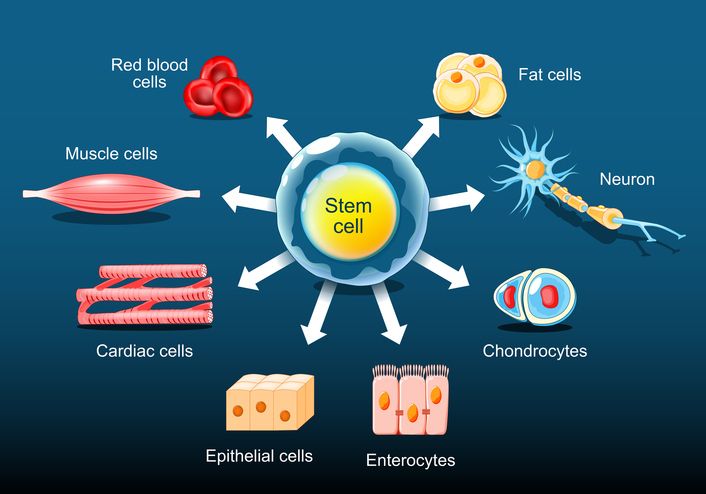
Author: Natalie Ng|Updated: 16 June 2025
If you're getting more sleep but still noticing dark circles under your eyes, common sleep myths might be part of the problem. A lot of people assume eight hours is the perfect amount for everyone, or that sleeping in on weekends can make up for lost rest. Some even count on naps to reset after a long day. But these habits don’t always help—and can sometimes make things worse for your skin, especially around the eyes. How you sleep, what time you go to bed, screen time before sleep, and even things like drinking at night all affect how your under eye area looks. These factors can affect blood flow, make blood vessels more visible, or cause puffiness that makes dark circles stand out more. If you’ve been using cold compresses, eye creams, or tea bags without much luck, it could be time to look at your sleep routine. In the next section, we’ll break down how much sleep you really need to get rid of dark circles—and which habits might be getting in the way.

Sleep Myth 1: You need 8 hours of sleep to get rid of dark circles

Sleep needs for dark circles are not the same for everyone
The idea that everyone needs eight hours of sleep to get rid of dark circles is one of the most common myths. In reality, sleep needs vary depending on age, daily activity, stress levels, and even your genetic predisposition. Some people feel well-rested with just six hours, while others need more than nine to avoid symptoms like tired eyes, dull skin, and under-eye puffiness.
What to focus on instead of just sleep hours
Rather than aiming for a fixed number, notice how your body responds to your usual rest:
• You wake up without an alarm
• You feel alert and focused during the day
• You don’t rely on naps or caffeine to stay awake
If these apply to you, you're likely getting enough rest to support blood circulation and reduce the appearance of dark circles.
Poor quality sleep and its effect on the under eye area
Sleeping for a full eight hours doesn't help much if your sleep is broken or too light. Poor-quality rest affects blood flow and can lead to dilated blood vessels around the eyes. This often causes eye bags, swelling, or dark circles under the eyes—especially if your skin is thinner or you're sensitive to stress hormone changes overnight.
Even with enough time in bed, these internal shifts can leave you looking tired and make it harder to reduce the appearance of dark eye circles using creams or home remedies.

Sleep Myth 2: Sleeping in on weekends makes up for lost rest

Weekend recovery sleep can disrupt your body’s natural rhythm
Sleeping late on weekends might feel like the easiest way to catch up after a busy week, but it doesn’t reset your sleep debt the way most people think. Your internal body clock—called the circadian rhythm—relies on regular sleep and wake times. When those patterns are inconsistent, especially with late weekend mornings, it can lead to what researchers call "social jet lag."
This mismatch can make you feel foggy, lower your mood, and disrupt your sleep for the rest of the week. It also affects your skin. Irregular sleep throws off blood circulation, which can make dark circles and eye bags more noticeable by Monday morning.
What happens when you try to catch up
Sleeping in doesn’t undo the effects of sleep deprivation from the workweek. It only disrupts your rhythm further. Here’s what tends to happen:
• Your natural sleep-wake cycle becomes irregular, making it harder to fall asleep Sunday night
• You wake up Monday feeling groggy and out of sync
• Your focus, mood, and energy drop for the rest of the week
• The under eye area may look more puffy and dark due to disrupted rest
This kind of inconsistency can lead to more visible signs of fatigue, such as swelling around the lower eyelids or dullness in skin tone.
Benefits of regular sleep for reducing dark circles
Sticking to a regular sleep schedule—even on weekends—can help maintain steady blood flow, reduce swelling, and support the skin’s recovery processes. Adequate sleep improves hydration levels in the skin and can lessen the appearance of dark circles, especially for those with thinner skin or a genetic predisposition.
Read More
Book Now to Experience
Miracle Eye Rescue Treatment
1 Minute Self-Registration
Date should not be before minimal date

Sleep Myth 3: Sleep before midnight gives better results
No special sleep benefits tied to midnight
Many people still believe that sleep before midnight is somehow more “restful,” but there’s no built-in magic in those hours. What helps reduce dark circles and puffiness is not the clock—it’s how well your sleep fits your natural circadian rhythm.
Whether you go to sleep at 10 PM or 1 AM, the most important thing is that your body gets enough uninterrupted, good-quality rest. When your sleep matches your internal rhythm and stays regular, your skin benefits—especially in the under eye area, where fatigue often shows up first.
What affects sleep quality more than timing
Going to bed early doesn’t guarantee your sleep will be restorative. Here’s what has a stronger impact on the appearance of dark circles than simply the hour on the clock:
• Getting full rest that fits your body’s natural pattern
• Keeping a regular schedule, even on weekends
• Creating a calm sleep environment (quiet, cool, dim)
• Avoiding interruptions that disturb deep sleep
These factors help reduce swelling, support blood circulation, and allow your skin to recover, especially in areas with thin skin like the lower eyelids.
Importance of aligning with your personal rhythm
Whether you’re naturally an early riser or a night owl, forcing yourself to sleep at a specific hour can backfire. If you go to bed too early for your body’s natural rhythm, you may struggle to fall asleep or wake up often—both of which lead to poor sleep quality and tired-looking eyes.
Instead of worrying about falling asleep before midnight, focus on:
• Listening to your body’s natural sleep signals
• Winding down with a quiet, relaxing routine
• Keeping your sleep and wake times regular throughout the week

Sleep Myth 4: Sleep position doesn’t affect dark circles
Impact of sleep position on puffiness and fluid retention
Many people don’t realize that the way you sleep can change the way your face looks in the morning. Lying on your stomach or side causes fluid to collect in the under eye area. Gravity pulls this fluid downward, especially overnight, leading to swelling and more visible dark circles under the eyes.
This effect becomes more noticeable with the ageing process, as skin loses firmness and becomes thinner around the lower eyelids. Blood vessels may appear darker and more pronounced, making dark circles look worse by morning.
Back sleeping reduces pressure and swelling
The best sleep position for reducing eye bags and puffiness is lying on your back with your head slightly elevated. This helps prevent fluid from pooling beneath the eyes by encouraging natural drainage.
Try this approach:
• Use a second pillow or a wedge to raise your head by about 15–20 degrees
• Choose a firm pillow that supports your neck and head without causing strain
• If you tend to roll over, place pillows beside you to keep your body in place
Sleeping on your back can also improve blood circulation to the face and reduce the pressure on one side of the face, which may otherwise lead to uneven skin texture or deeper under eye shadows over time.
Small changes can reduce swelling in the under eye area
Adjusting your sleep position isn’t always easy, especially if you’re used to sleeping on your side. But even small changes can help reduce swelling and improve the appearance of dark circles. You may also consider combining position changes with other home remedies like cold tea bags or a cold compress in the morning to further reduce puffiness.
Book Now to Experience
Miracle Eye Rescue Treatment
1 Minute Self-Registration
Date should not be before minimal date

Sleep Myth 5: Screen time only affects sleep quality
Screens before bed affect both sleep and skin
Looking at your phone, tablet, or laptop before bed doesn’t just make it harder to fall asleep—it also affects your skin, especially around the eyes. Blue light exposure delays melatonin production, a hormone that signals your body it's time to rest. This makes it harder to feel sleepy at the right time, reducing both sleep quantity and quality.
The result? Sleep deprivation that can lead to dark circles, eye bags, and puffiness, especially in people with thinner skin around the lower eyelids.
Blue light and bright environments delay rest
Many people focus only on screen light, but it’s not just your phone that’s the issue. Bright lighting of any kind in the evening can confuse your body’s natural rhythm and delay melatonin release.
Key things that impact your ability to get rid of dark circles:
• Exposure to any strong light sources late in the day
• Using screens within two hours of bedtime
• Staying in brightly lit rooms after sunset
All of these factors affect blood circulation and increase the chance of waking up with dull, tired-looking skin or swelling under the eyes.
Mentally active screen use increases alertness
It’s not just the light from screens—it’s what you’re doing on them. Evening activities like scrolling through social media, watching intense videos, or checking work emails keep your brain in a state of alertness. This mental stimulation can trigger stress hormones, like cortisol, and make it harder for your body to shift into rest mode.
Even after you turn off your device, your brain may still stay active. This affects sleep depth and leads to a tired complexion, puffier eyes, and more visible circles under the eyes.
Try limiting screen time close to bedtime and create a calm sleep environment instead. Reducing eye strain and improving sleep quality helps minimize the appearance of dark circles naturally.

Sleep Myth 6: Alcohol helps you sleep better
Alcohol reduces sleep quality and worsens eye appearance
Having a drink before bed might make you feel sleepy, but it doesn’t help your body get the kind of rest it needs. Alcohol interferes with the natural sleep cycle by blocking deeper stages of rest, especially REM sleep. This leads to lighter, more fragmented sleep—and that shows up quickly on your skin.
Interrupted rest can slow down blood circulation and cause fluid to build up, making dark circles and puffiness under the eyes more visible. If your skin is already thin around the eye area, these effects appear more quickly and last longer.
How alcohol disrupts sleep and skin recovery
While alcohol may help you fall asleep faster, it does more harm than good overnight. Here’s how it affects your body and the under eye area:
• Blocks REM sleep, which is needed for mental recovery and cell repair
• Causes frequent wake-ups during the second half of the night
• Leads to dehydration, which dulls the skin and reduces moisture under the eyes
• Increases swelling and can make blood vessels more noticeable by morning
As a result, dark circles become more visible and the skin can look more sunken or inflamed, especially if this habit happens often.
Simple changes that support healthier rest
Instead of using alcohol as a way to wind down, switch to habits that support deeper rest and better skin recovery. A quiet bedtime routine, staying hydrated, and sleeping in a dark, cool room can all support better blood flow and reduce swelling around the eyes.
Book Now to Experience
Miracle Eye Rescue Treatment
1 Minute Self-Registration
Date should not be before minimal date

Sleep Myth 7: Dark circles are purely genetic
Genetics influence dark circles, but they’re not the only cause
While your genes can play a role in how noticeable your dark circles are, they’re only part of the picture. Many people with a family history of dark circles also experience them more often, but this doesn’t mean they’re untreatable or permanent.
The skin under the eyes is naturally thinner, which makes blood vessels and pigmentation more visible. If you inherit thinner skin or deeper eye sockets, shadows and discoloration may show more easily. But external factors—like sleep deprivation, dehydration, or poor lighting habits—can make the problem worse.
Everyday habits can make dark circles more visible
Dark eye circles often become more noticeable when combined with other daily stressors. Even if you’re genetically prone to them, certain habits can make them appear darker or more swollen. These include:
• Poor sleep quality or irregular sleep patterns
• Eye strain from too much screen time
• Dehydration, which causes the skin to lose volume and look dull
• High stress levels, which affect blood circulation and fluid retention
These factors lead to puffiness, dilated blood vessels, and changes in the under eye area that make dark circles stand out more—even when they’re partly genetic.
Ways to support your under eye area
You can improve the appearance of dark circles with small changes that reduce puffiness and improve skin condition:
• Stay hydrated to support skin moisture and blood circulation
• Use an eye cream with ingredients like vitamin K or caffeine
• Take regular screen breaks to reduce eye strain
• Apply cold tea bags or ice cubes to help reduce swelling
• Gently massage the under eye area to encourage lymphatic drainage
These steps won’t change your genetics, but they can help reduce the appearance of dark circles and support a healthier, more rested look.

Sleep Myth 8: Naps can replace proper nighttime sleep
Naps can’t fix long-term sleep deprivation
Short naps might help you feel more alert for a few hours, but they don’t replace the deep, uninterrupted rest your body needs at night. Your circadian rhythm is designed for longer periods of sleep during the night—not short bursts during the day.
If you're regularly missing sleep at night and trying to catch up with naps, you're likely building sleep debt. This debt affects your skin and the under eye area by disrupting blood flow, increasing fluid retention, and leaving you with puffy eyes and darker circles.
How naps affect the appearance of dark circles
While a short nap (about 20 minutes) may offer a quick energy boost, relying on naps too often can lead to irregular sleep patterns. This causes deeper issues that are hard to correct with short-term fixes. Here’s what happens:
• You miss out on long, deep sleep stages that help restore skin health
• Your body’s internal rhythm becomes irregular, affecting hormones and circulation
• The under eye area becomes more prone to puffiness, darkness, and fatigue-related symptoms
Dark circles often appear more pronounced when your sleep is fragmented or inconsistent. This is because your skin doesn’t get the recovery time it needs, and any existing swelling or discoloration becomes harder to reduce.
Regular nighttime sleep is more effective
To get rid of dark circles and improve your overall skin tone, focus on regular, adequate sleep at night. This gives your body time to repair cells, support hydration, and maintain healthy blood circulation—all essential for reducing eye bags and dullness.
While occasional naps can help after a poor night’s sleep, they’re not a long-term solution. Prioritizing full nighttime rest is more effective for both your energy and your appearance.
Book Now to Experience
Miracle Eye Rescue Treatment
1 Minute Self-Registration
Date should not be before minimal date

Other causes of dark circles besides lack of sleep
Sleep plays a big role in how your under eye area looks, but it’s not the only cause of dark circles. You can sleep well and still experience dark eye circles due to a mix of internal and external influences. These other factors may make your skin look darker, puffier, or more hollow—especially if your skin is thinner or prone to pigmentation.
Common causes include:
• Dehydration: Not drinking enough water reduces moisture in the skin, making dark circles appear more sunken and dull
• Sun exposure: UV damage can trigger hyperpigmentation and lead to darkening of the under eye area over time
• Aging: Collagen loss and thinning skin make blood vessels more visible and can deepen shadows under the eyes
• Genetic predisposition: Some people naturally have more pigment or less volume in the lower eyelids
• Poor blood circulation: This can cause blood to pool or become more visible through the skin, leading to a darker tone
• Stress: Heightened stress hormone levels can interfere with sleep and increase puffiness or discoloration

Home remedies to help get rid of dark circles
You don’t need a full skincare overhaul to reduce dark circles—small, regular habits can help support skin recovery and improve how your under eye area looks. While these remedies won’t erase genetic factors, they can improve moisture, reduce swelling, and help with blood flow under the skin.
Some simple home-based treatments include:
• Cold compress: Applying a cold compress helps constrict blood vessels and reduce puffiness, especially in the morning
• Cold tea bags: Green tea or black tea bags contain antioxidants and caffeine, which may help reduce swelling and improve blood circulation when applied cold to the lower eyelids
• Gently massage the eye area: Light tapping or circular massage helps drain fluid buildup and reduce under eye bags
• Use an eye cream: Look for ingredients like vitamin K, caffeine, or peptides, which may help brighten the under eye area and support thinner skin
• Ice cubes wrapped in a soft cloth: This helps reduce swelling without irritating the skin, especially after a poor night of sleep
• Staying hydrated: Drinking enough water throughout the day keeps skin plump and reduces the chance of dryness or dullness under the eyes
Daily habits for long-term improvement
In addition to quick fixes, daily routines make a difference in how the skin around your eyes looks over time:
• Wear sunscreen daily to prevent sun-induced hyperpigmentation
• Remove makeup gently to avoid irritating the thin skin under your eyes
• Follow a regular sleep schedule to reduce fluid buildup and improve circulation
• Take short breaks from screens to reduce eye strain and stress on the area

Support your sleep results with Miracle Eye Rescue Treatment
Why sleep alone might not be enough
Getting enough sleep is essential for reducing dark circles—but sleep alone doesn't always deliver the results you expect. Factors like thin skin, poor blood circulation, sun exposure, and stubborn under-eye fat can all limit the improvements you see, even if you're sleeping well every night.
When dark circles, puffiness, or fine lines remain visible despite your best efforts to stay rested and hydrated, it may be time to add professional support. That’s where treatments like Miracle Eye Rescue Treatment can make a difference.
How Miracle Eye Rescue Treatment works
The Miracle Eye Rescue Treatment is a non-invasive procedure that targets common causes of eye-area fatigue: dark circles, under eye bags, and fine lines. It uses triple-wavelength radiofrequency (RF) energy combined with red and blue light therapy to improve blood circulation, dissolve excess eye bag fat, and stimulate collagen under the skin.
Here’s how it supports the under eye area:
• Improves blood circulation to brighten the skin and reduce the appearance of dark circles
• Dissolves fat in puffy eye bags with gentle thermal energy and light therapy
• Boosts collagen production, helping to lift sunken areas and smooth fine lines
• Reduces fluid retention that can lead to swelling or eye puffiness
• Safe for most skin types, with no needles, no downtime, and no pain
Why it works well with proper sleep
While adequate sleep helps manage swelling and supports the skin’s natural repair process, the Miracle Eye Rescue Treatment enhances those results by directly targeting deeper layers of the skin that sleep alone can’t affect. It helps accelerate visible improvements in the appearance of dark circles, eye bags, and fine lines—even if those issues are worsened by genetics, fatigue, or aging.
See visible results faster
Unlike creams or temporary home remedies, this treatment works through all layers of skin to support long-term improvements. With regular sessions, most clients see a brighter under eye area, smoother texture, and reduced puffiness—without surgery or recovery time.
Ready to give your eyes the care they deserve?
Book your Miracle Eye Rescue Treatment today and wake up to a fresher, firmer look—whether you’ve had eight hours of sleep or not.
New Beauty's R6 Miracle Eye Rescue TreatmentBook Now to Experience
Miracle Eye Rescue Treatment
1 Minute Self-Registration
Date should not be before minimal date
FAQ
How does dehydration make dark circles look worse?
When your body is dehydrated, the skin loses volume and becomes thinner—especially in the under eye area. This makes blood vessels more visible, which can lead to darker circles under the eyes. Lack of moisture also exaggerates fine lines and puffiness, making the skin appear tired and sunken. Drinking enough water daily helps plump the skin and support healthy blood circulation around the eyes.
Can vitamin deficiencies cause dark circles under the eyes?
Yes, low levels of certain vitamins—such as vitamin K, vitamin C, and iron—can contribute to the appearance of dark circles. Vitamin K supports healthy blood clotting and circulation, while vitamin C helps strengthen the skin barrier. Iron deficiency can cause poor oxygen delivery to tissues, which may lead to a dull or shadowed complexion, especially around the eyes. If dark circles persist despite rest and hydration, it may be worth checking for underlying nutritional gaps.
Does sun exposure make dark circles worse over time?
Frequent sun exposure can trigger melanin production, which darkens the skin and worsens the appearance of hyperpigmentation—especially in delicate areas like the under eye. UV rays also break down collagen, leading to thinner skin and more visible blood vessels. Wearing sunglasses and applying sunscreen daily helps prevent sun-induced darkening and slows down the aging of the eye area.
Is eye strain from screens linked to dark circles?
Yes. Prolonged screen time can cause eye strain and tension in the muscles around your eyes, which may increase blood flow and lead to dilated blood vessels. This can make the skin under your eyes appear darker. Taking regular screen breaks and practicing the 20-20-20 rule (every 20 minutes, look at something 20 feet away for 20 seconds) can help reduce the effects of eye strain.
What are the best ways to improve blood circulation under the eyes naturally?
To support blood flow in the under eye area, try gentle massage using your fingertips or a cold tool like a jade roller. You can also apply cold tea bags, which contain caffeine and antioxidants that may help reduce swelling and support capillary circulation. Staying active, managing stress, and getting regular sleep also contribute to healthy blood circulation, which can help brighten the eye area and reduce the appearance of dark circles.
Recommended Articles
COPYRIGHT© NEW BEAUTY MANAGEMENT LIMITED 2025. ALL RIGHT RESERVED.




